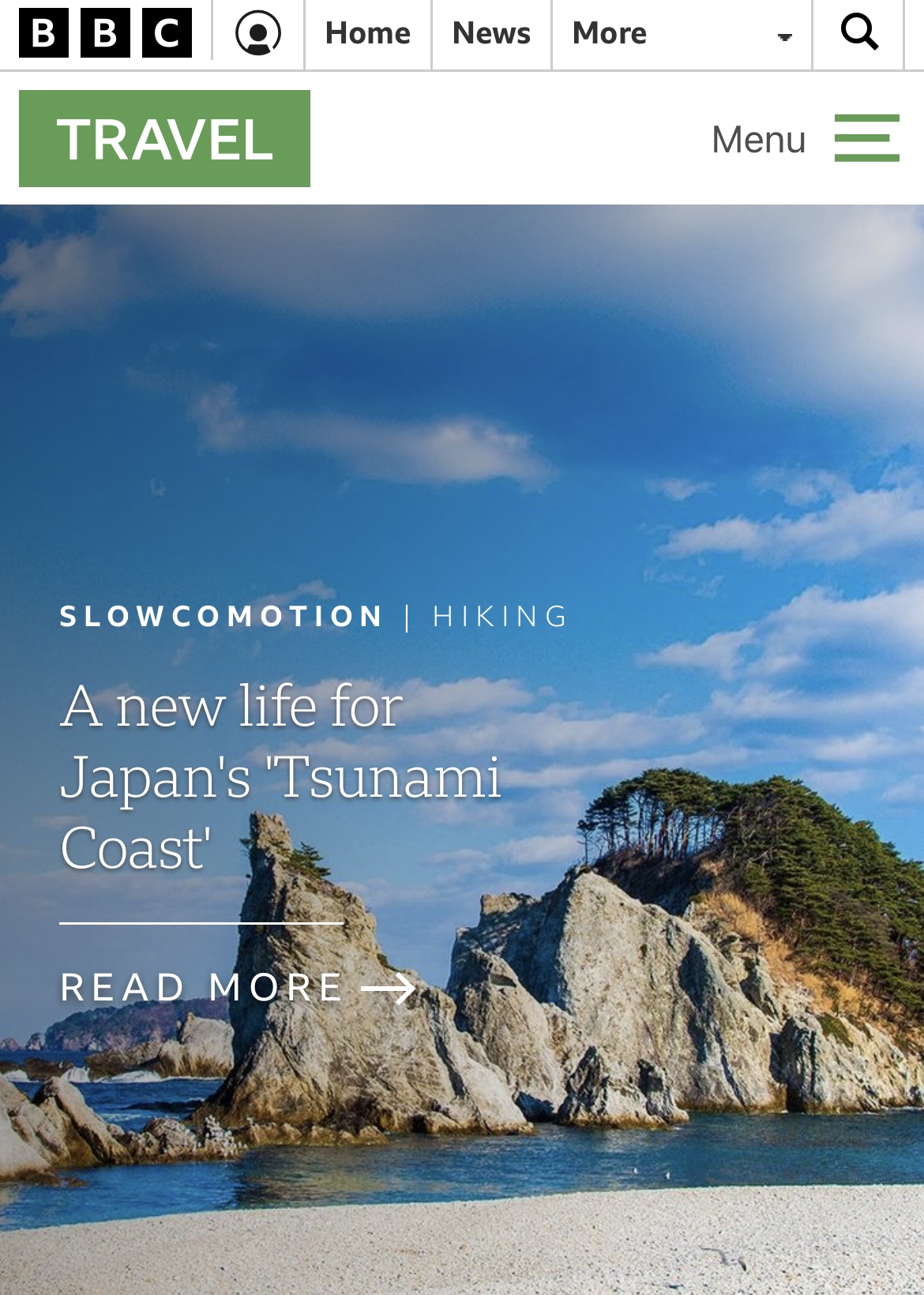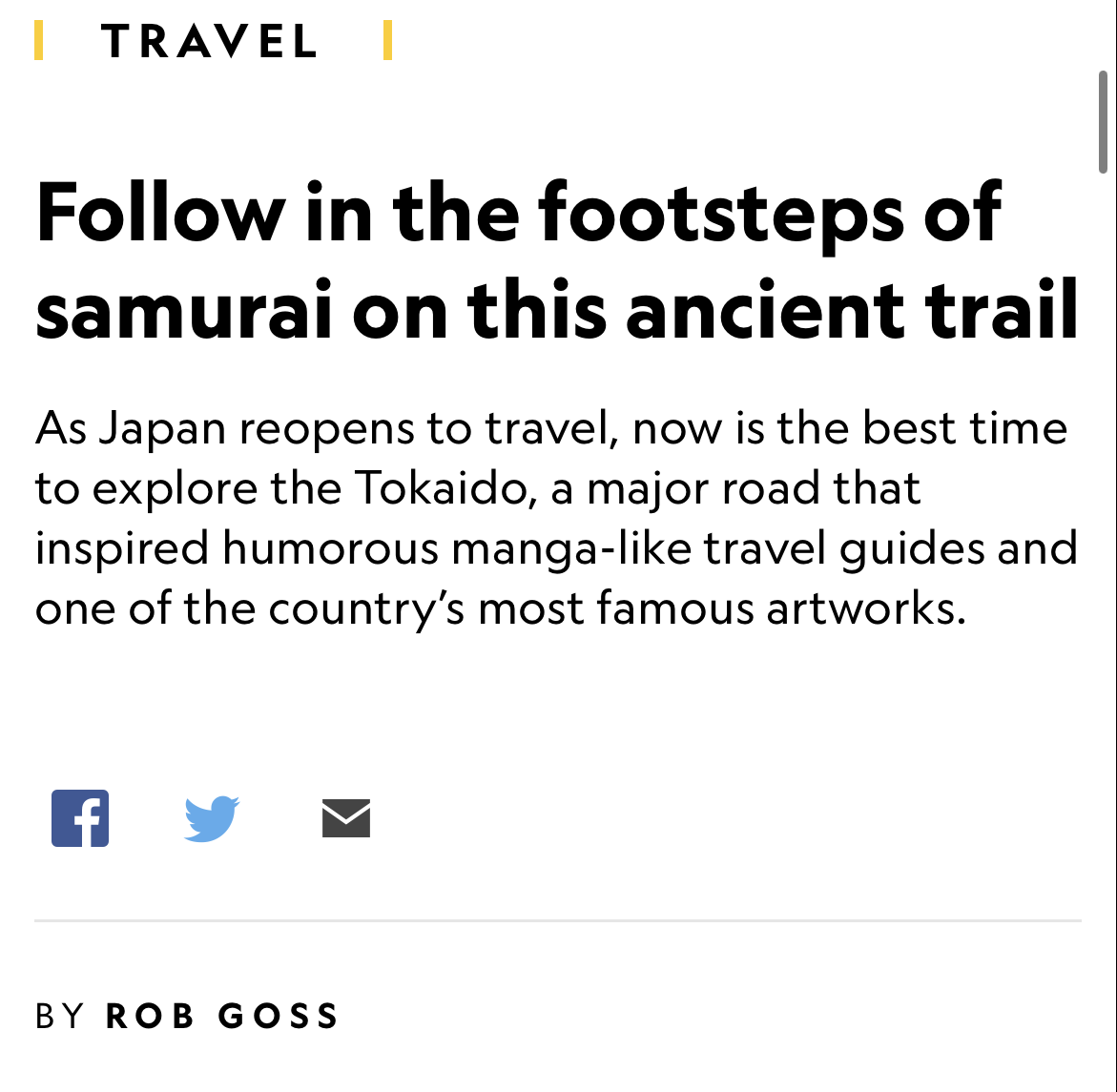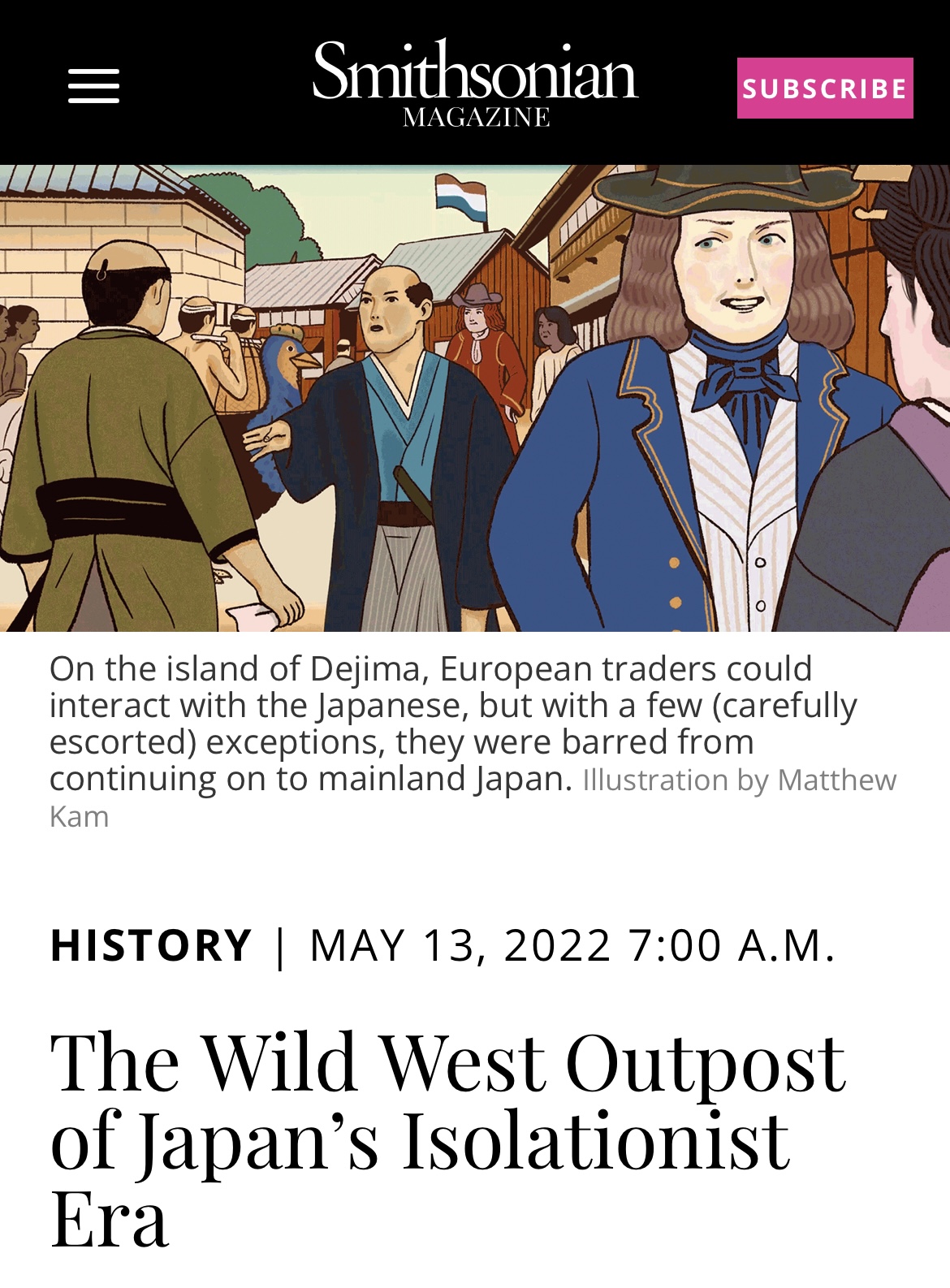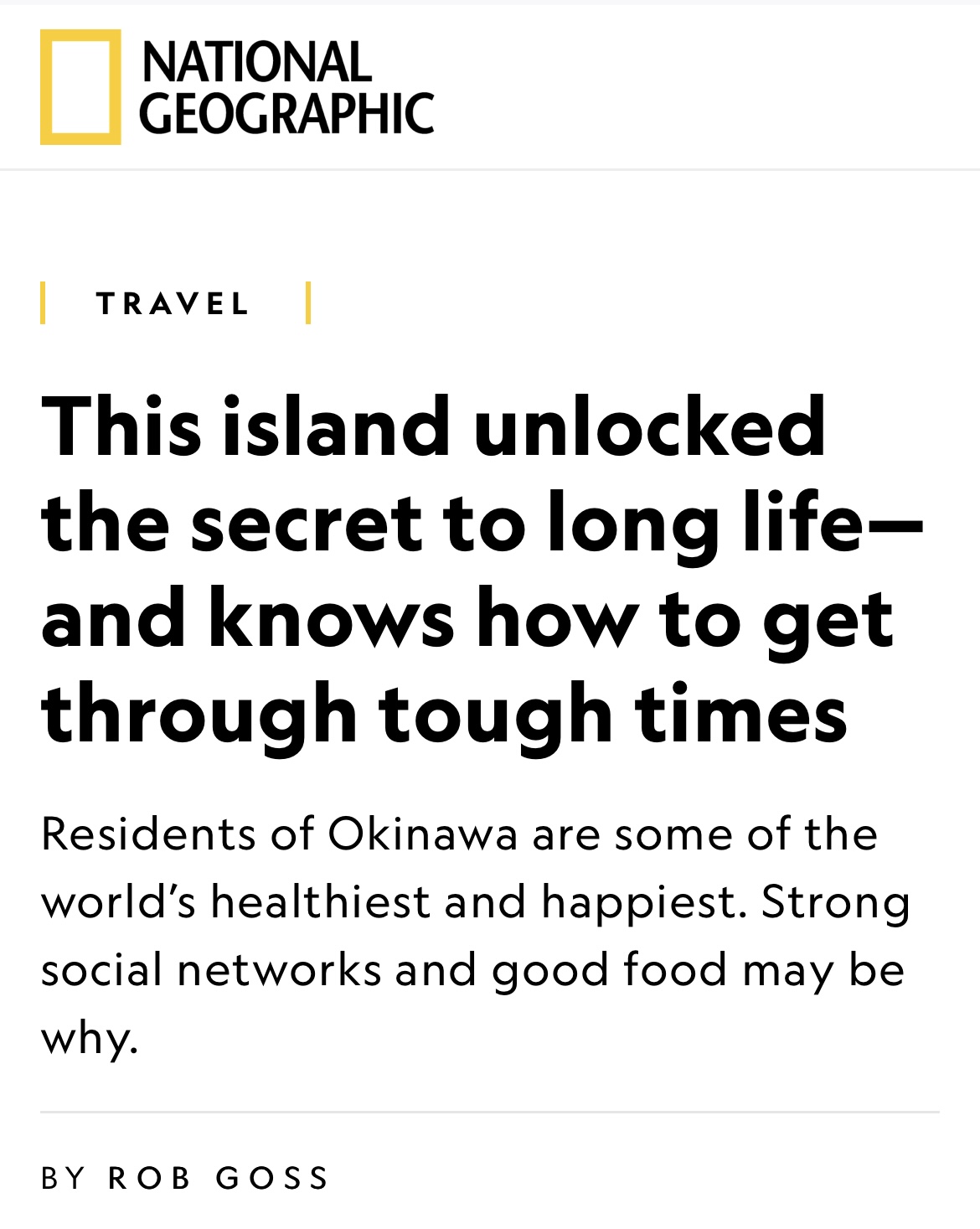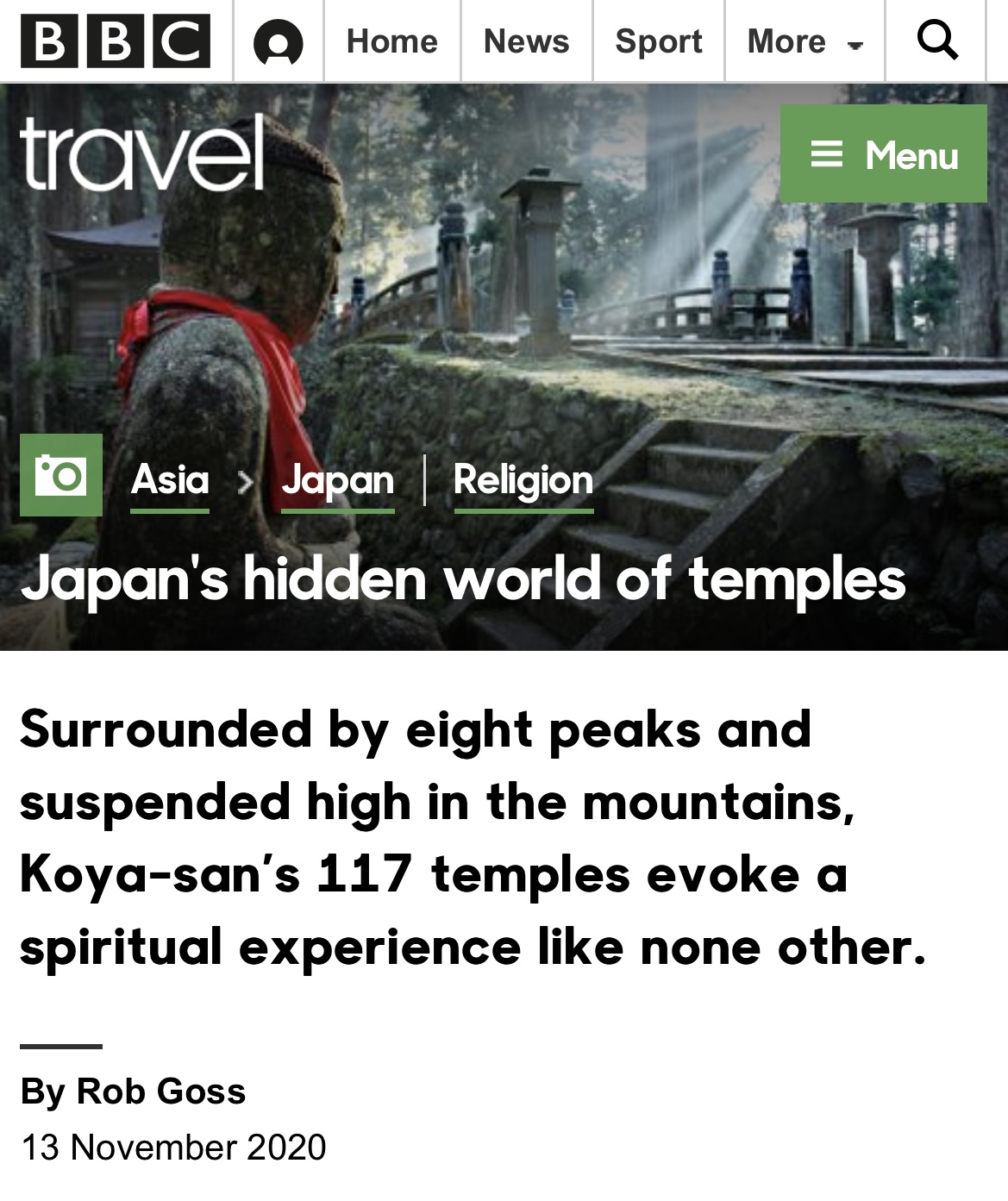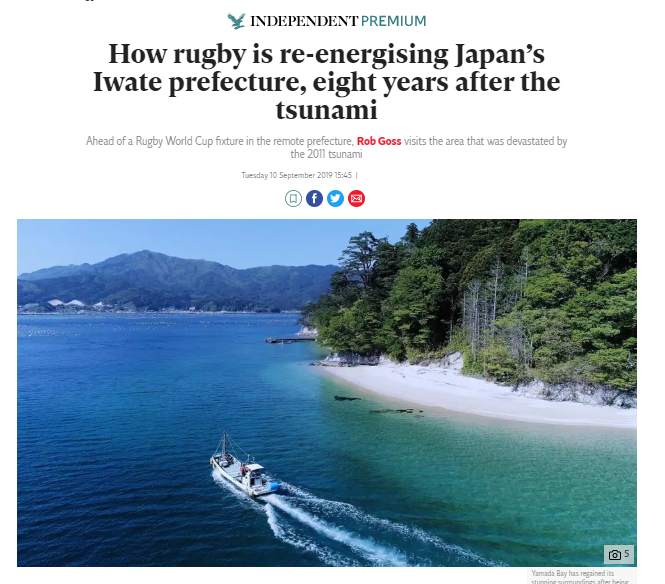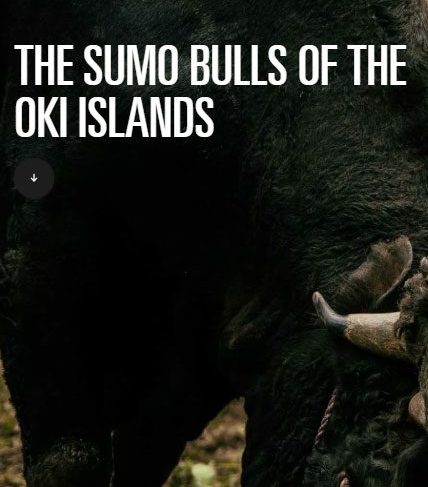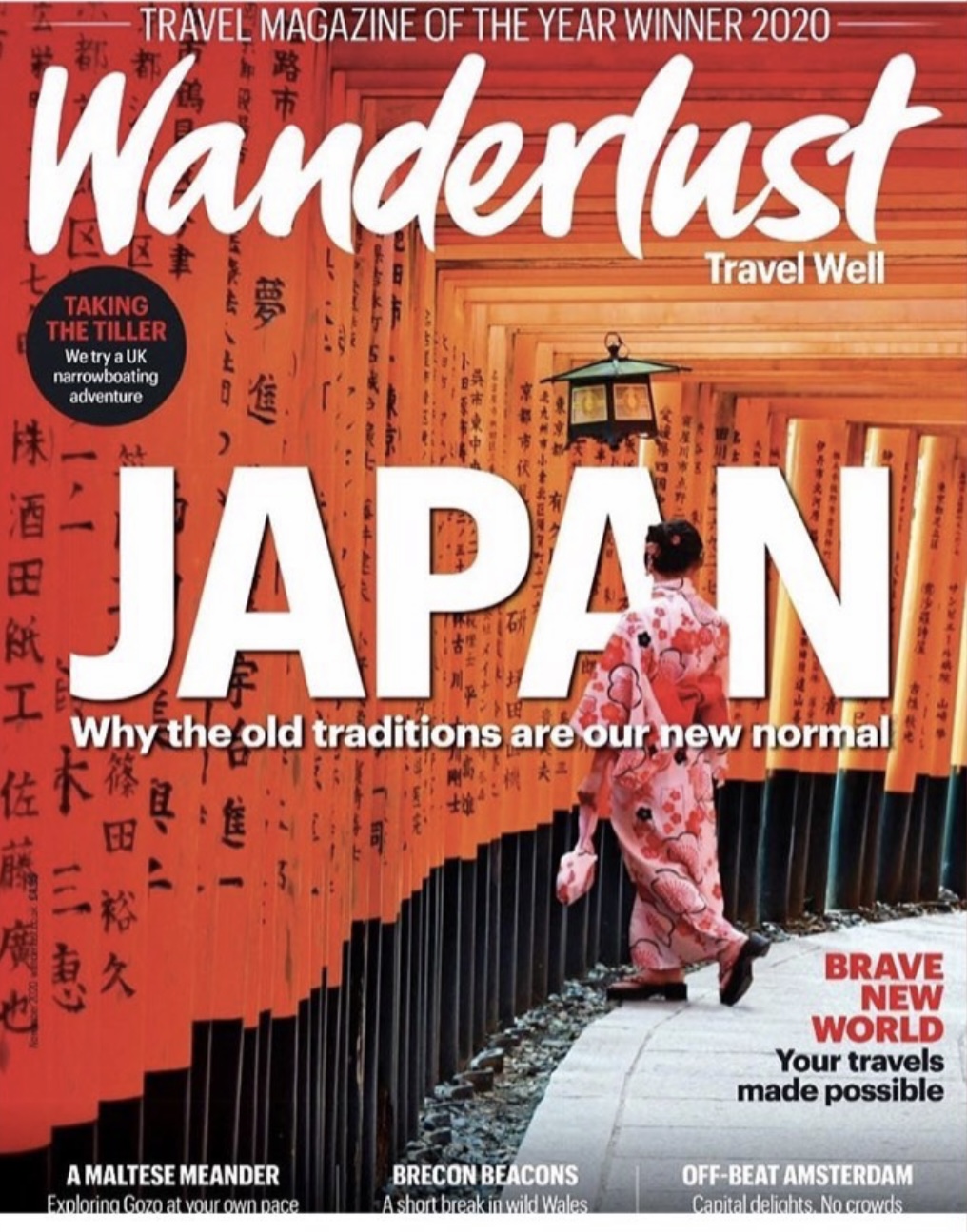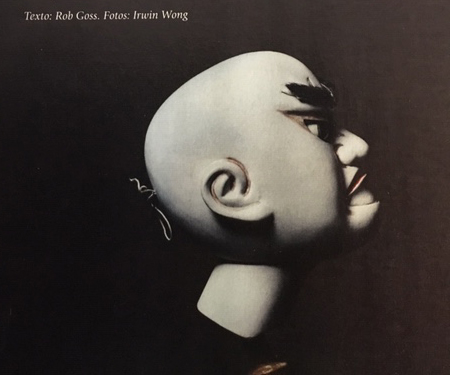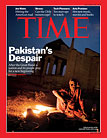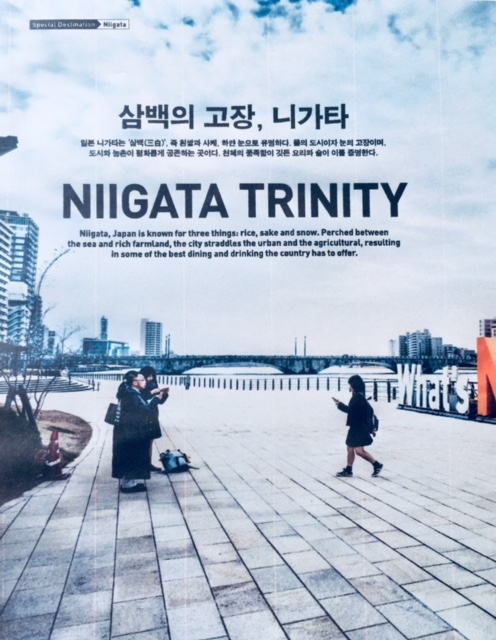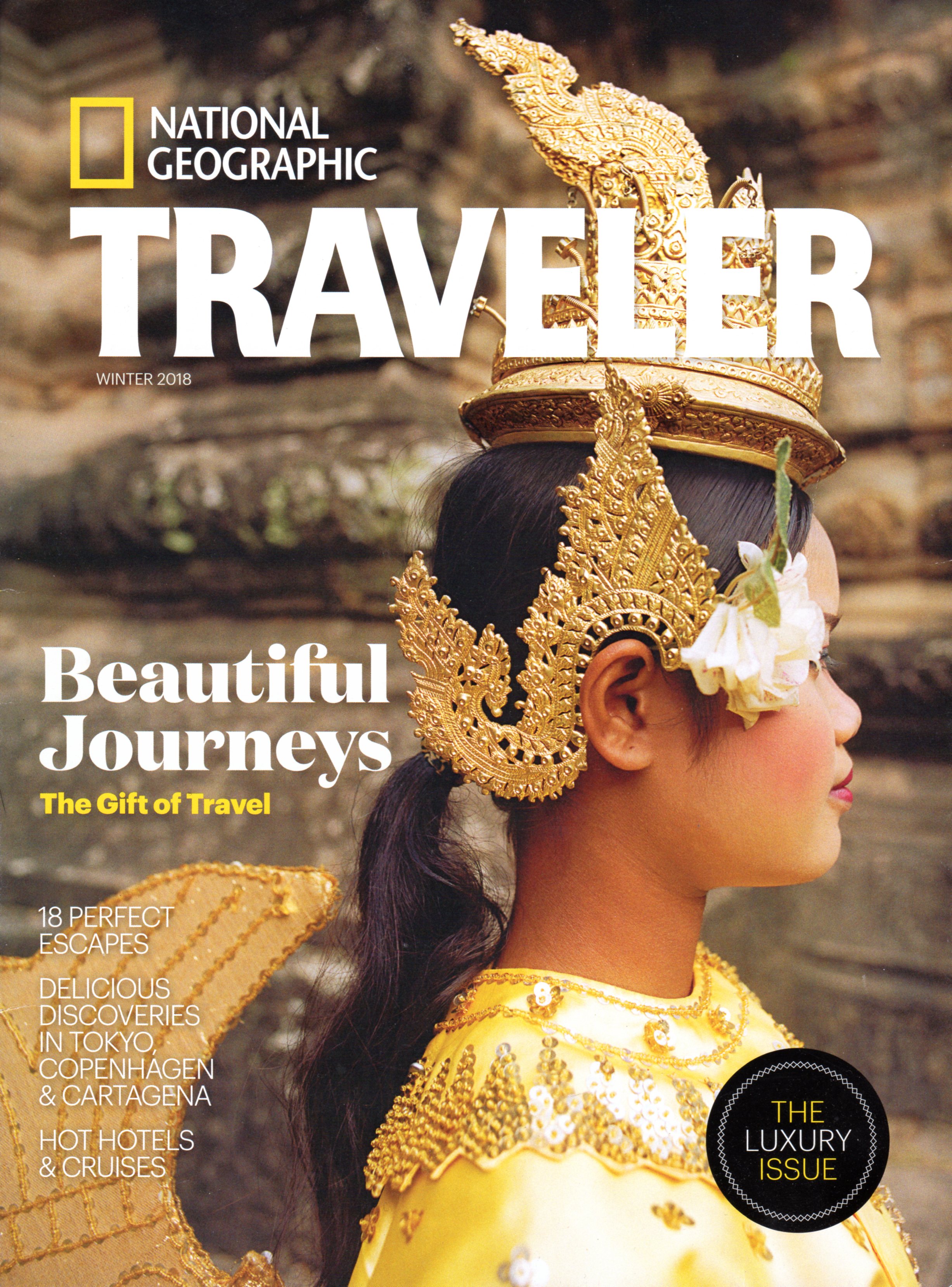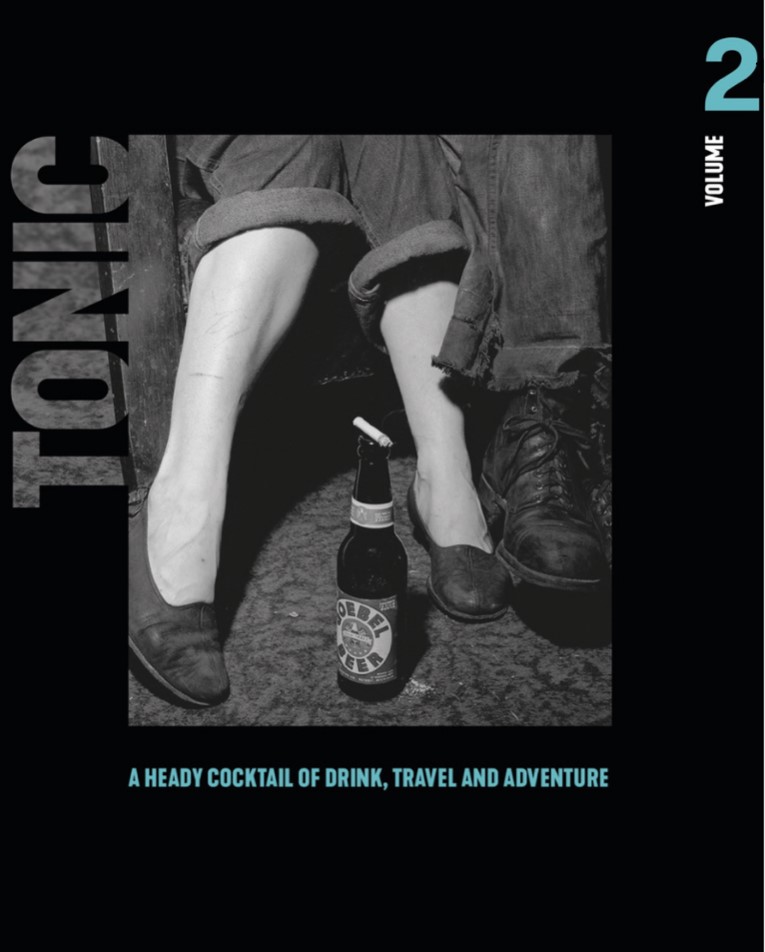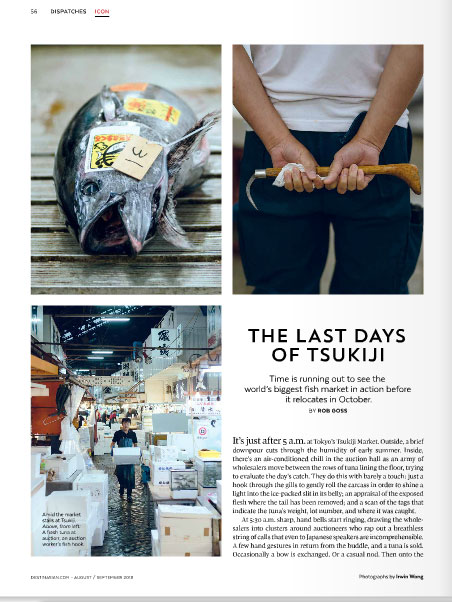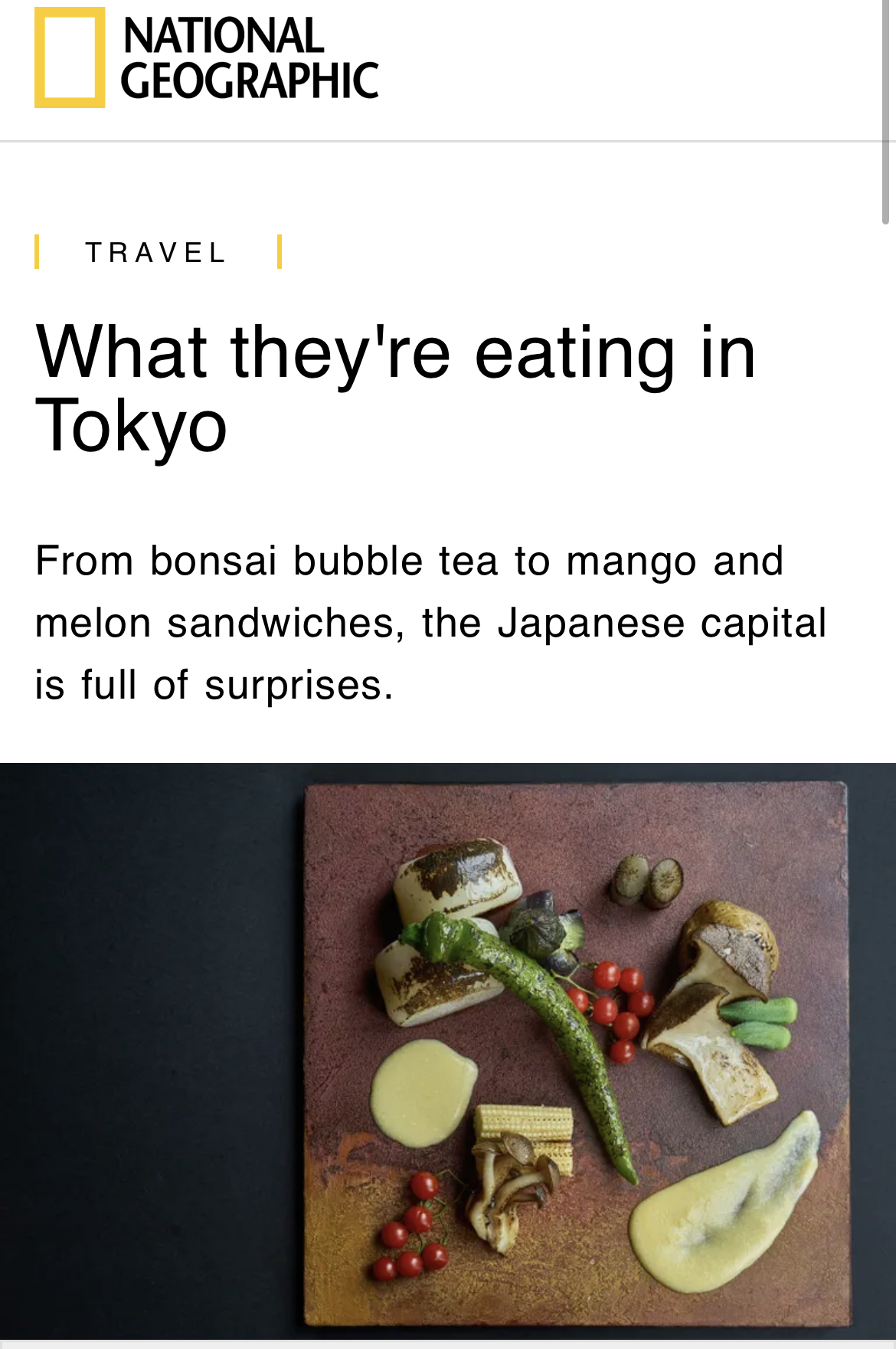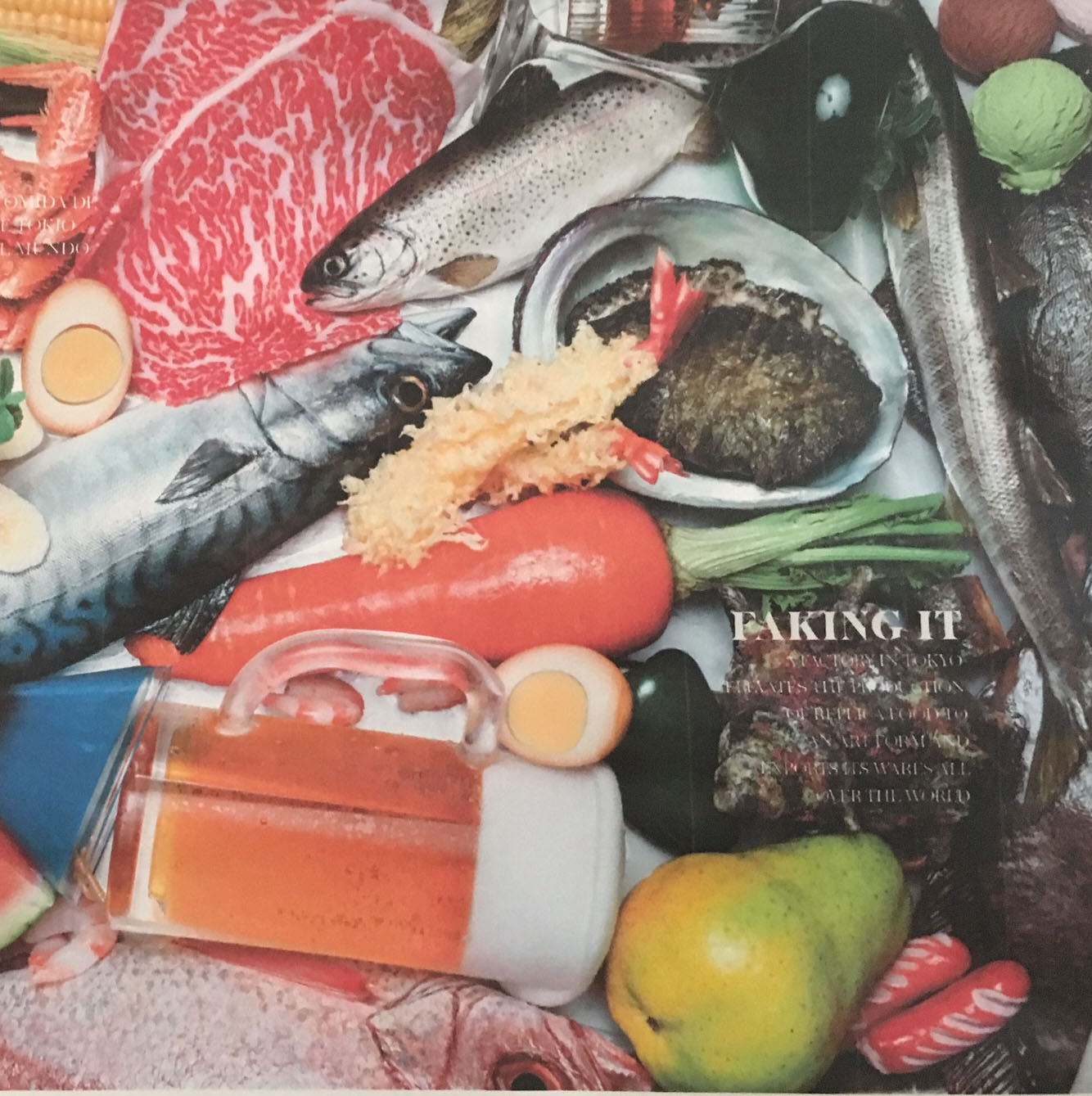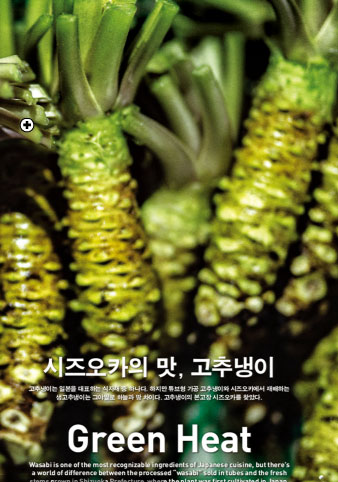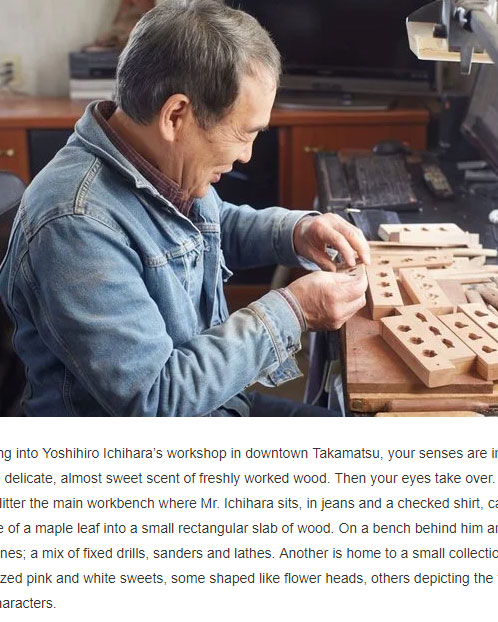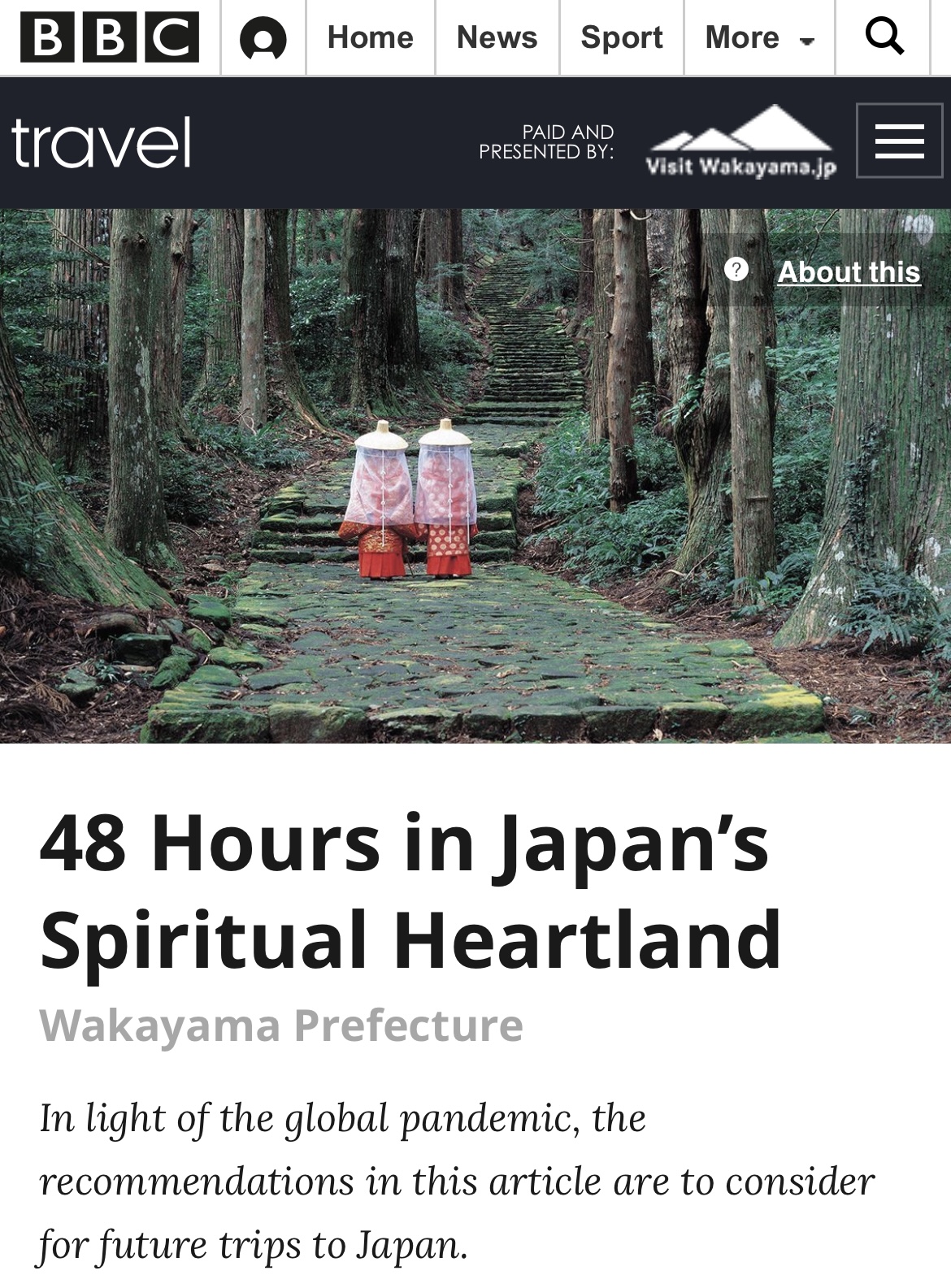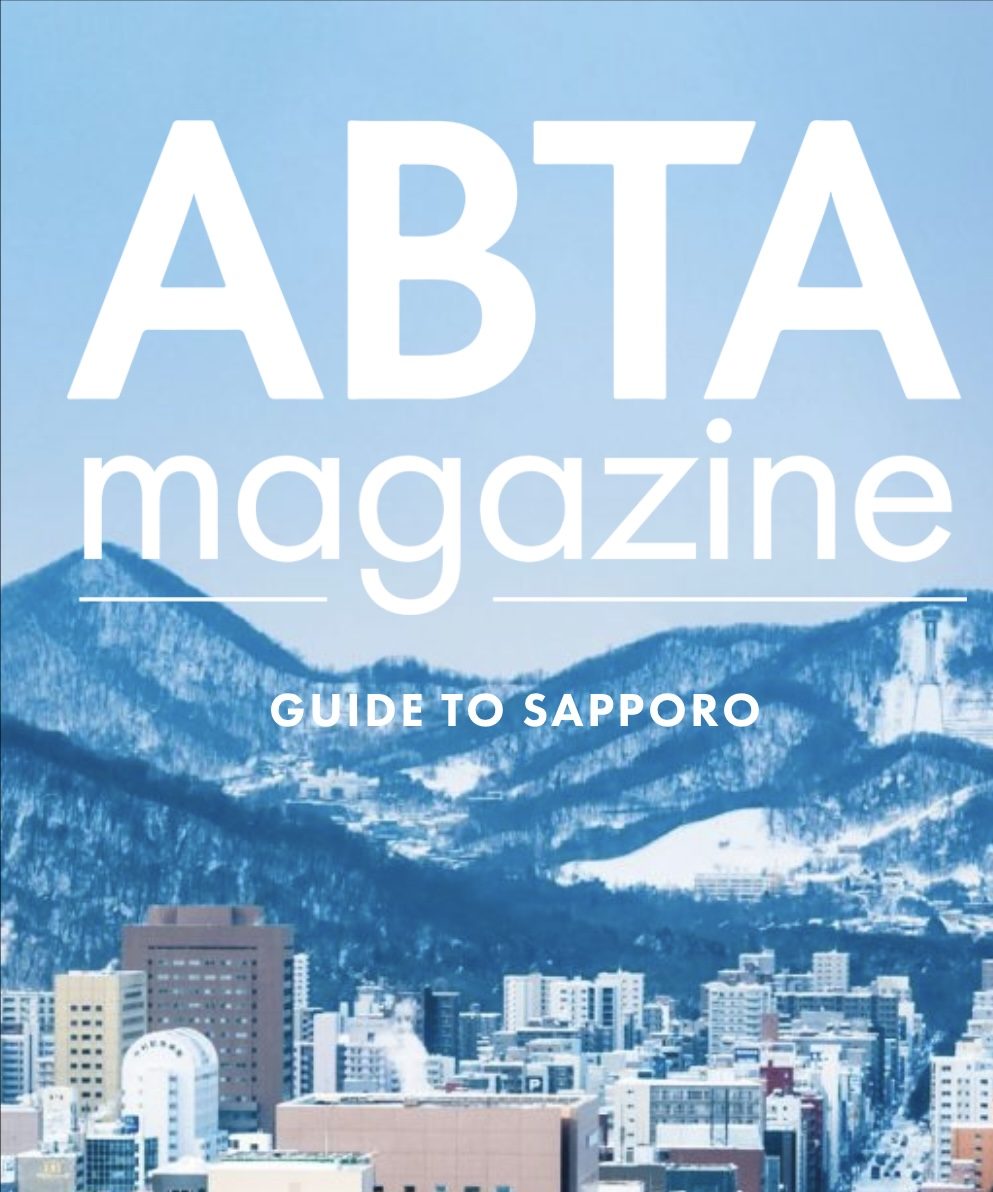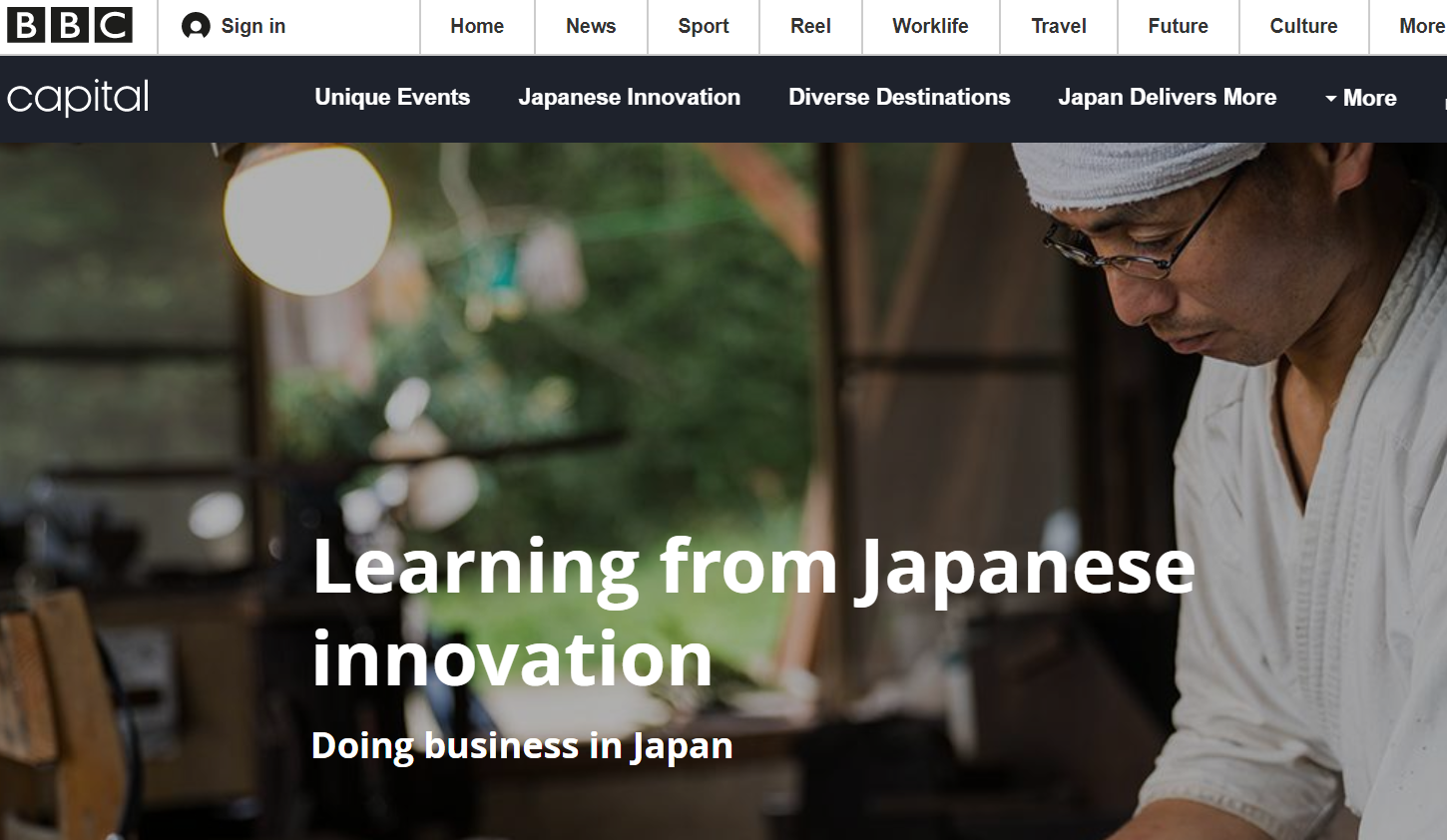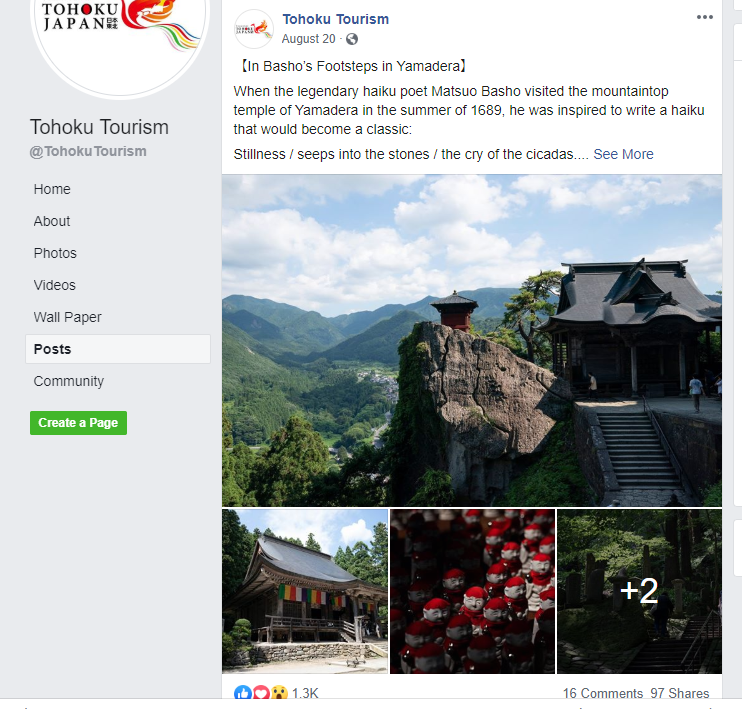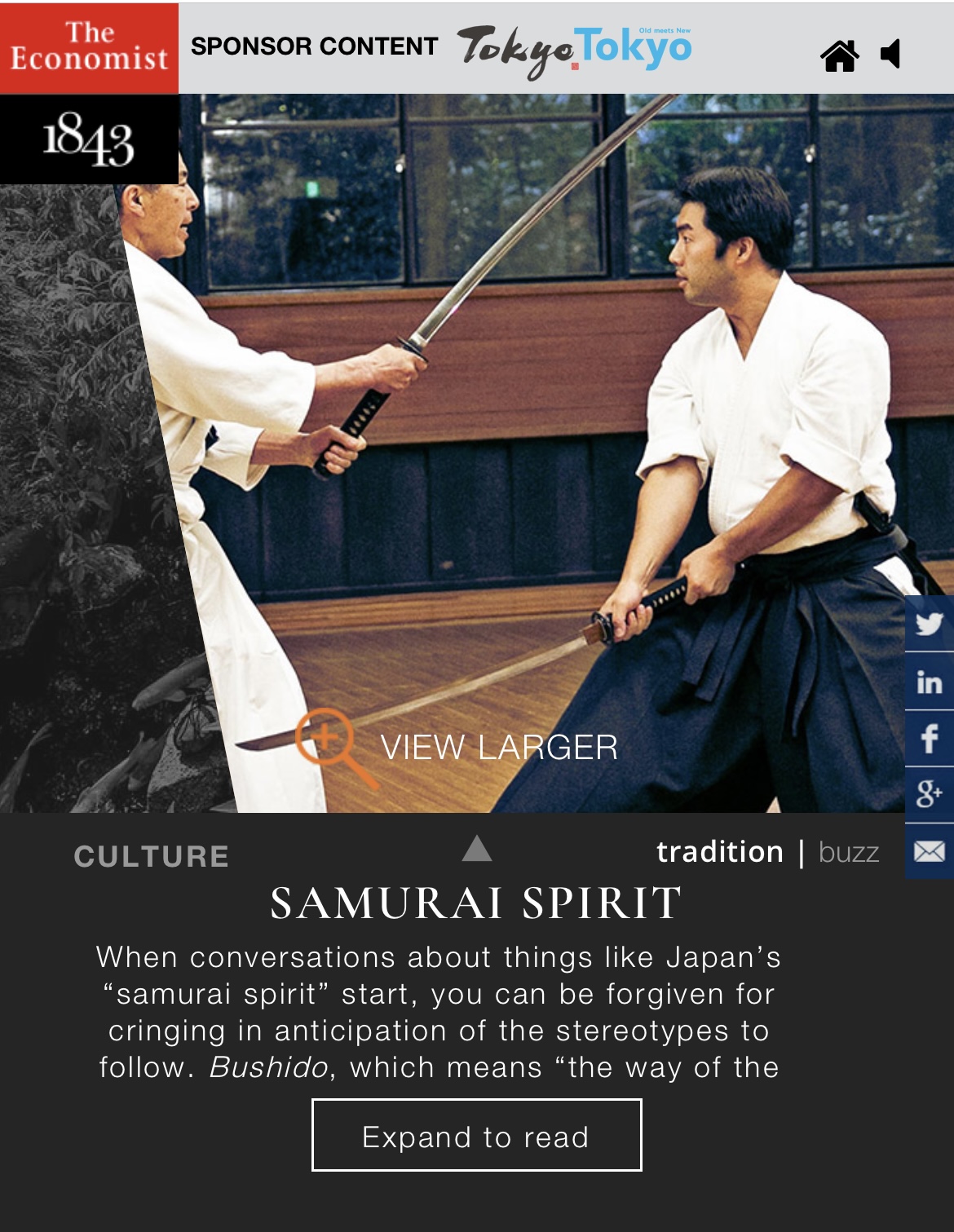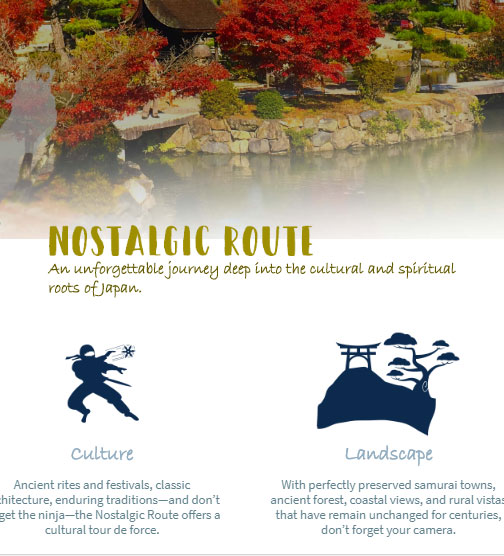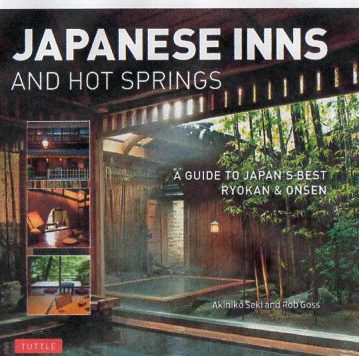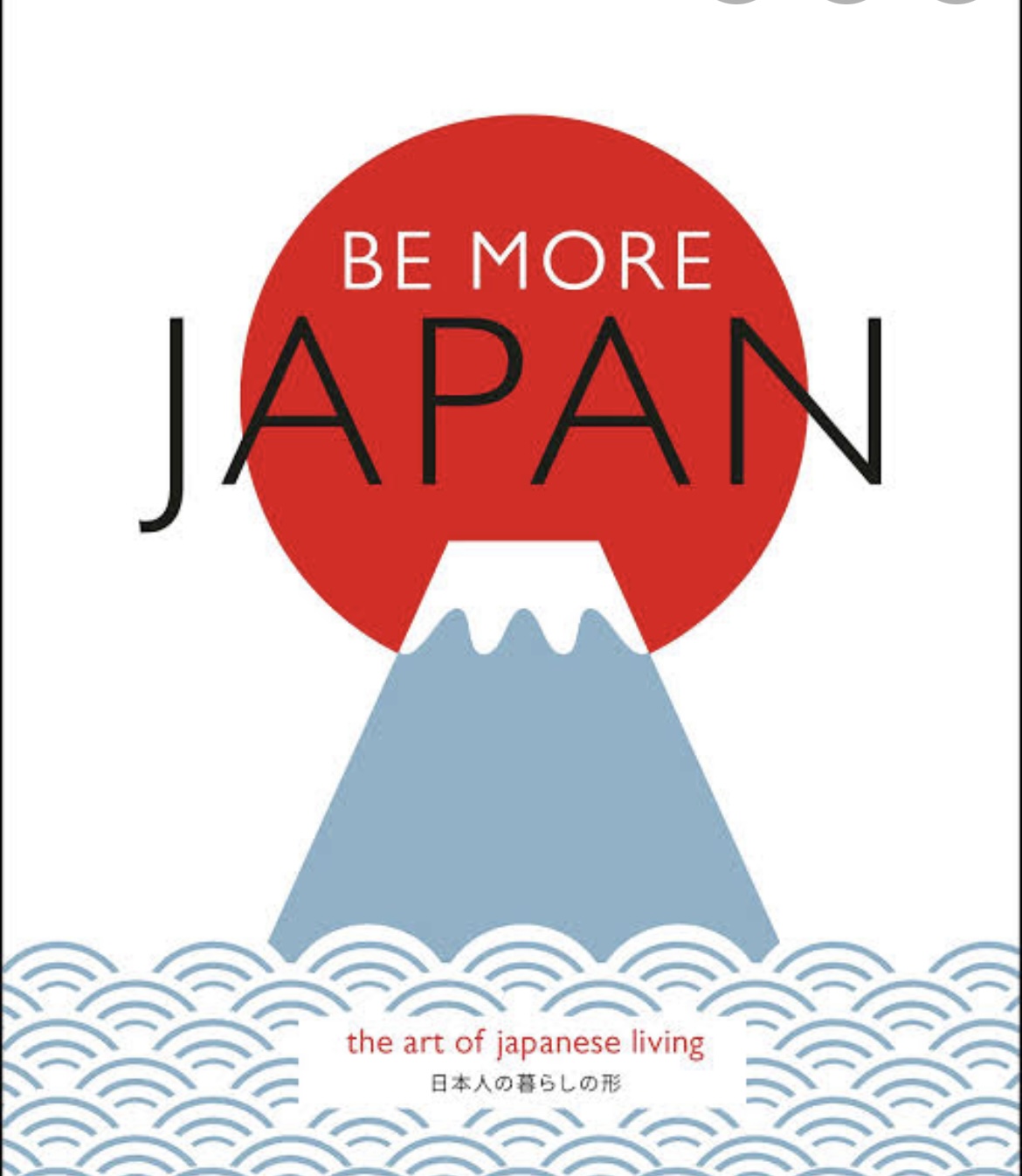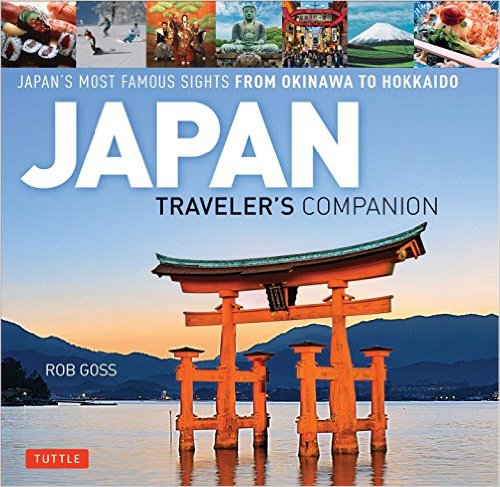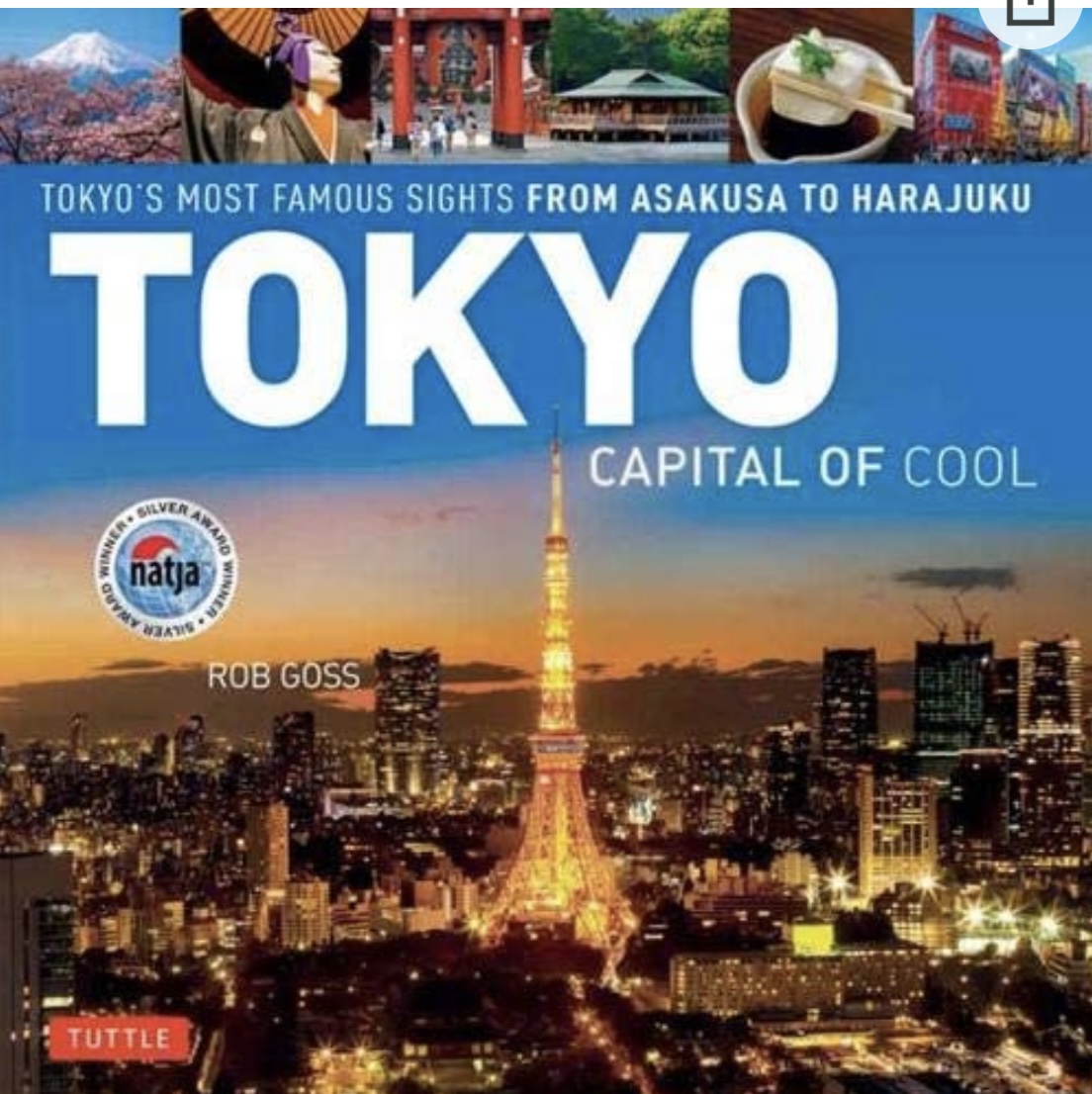Travel & Culture Food & Drink Content Marketing Books
Travel & Culture
A New Life for Japan's Tsunami-hit Coast - BBC Travel
"After two days hiking along Japan's rugged north-eastern coast, my son and I had just enough energy left to run down to Aketo Beach, rip off our shoes and socks and go wading in the chilly Pacific.
Standing in the sea, the light just beginning to fade, we heard nothing except the gentle lapping of shin-high waves. A few seagulls aside, the beach was all ours. But back across the grey stretch of sand was a reminder that nature wasn't always this calm: a mangled chunk of seawall with a written dedication remained as a memorial to the horrors that unfolded here just 10 years earlier.
On the afternoon of 11 March 2011, a 9.0-magnitude earthquake struck deep beneath the ocean 130km to the east. The fourth-largest quake in the world since seismic recording began in 1900, the blast was so powerful that it shifted the Earth's axis and redistributed its mass. It rattled Japan's north-eastern Tohoku region violently for nearly six minutes and even brought Tokyo, 400km to the south, to a sudden, panicked stop..."
.
Winner of a Bronze Prize (destination travel) at the 2022 North American Travel Journalists Association Awards.
Follow in the Footsteps of Samurai on this Ancient Trail - National Geographic
A look at the old Tokaido road, which connected Kyoto to Edo (Tokyo) in Edo era (1603-1868) and left behind cultural legacies ranging from woodblock prints to the earliest guidebooks. Winner of a Gold Prize (cultural travel) at the 2022 North American Travel Journalists Association Awards.
Unlocking the Mystery of Japan's Perfect Paper - National Geographic
"Every summer, giant warriors roam the Japanese city of Aomori. Lit from within by lanterns, these formidable paper floats are the centerpiece of the Nebuta Matsuri, a weeklong evening festival in August and one of Japan’s biggest seasonal events..."
Accompanied by taiko drummers and dancers, the floats depict scenes from kabuki and Japanese mythology. Each takes months to design and make, says float maker Hiroo Takenami, and for much of the Nebuta Matsuri’s 300-year history they were covered only in washi, a type of paper handmade from the paper mulberry plant.
The Wild West Outpost of Japan's Isolationist Era - Narratively / Smithsonian
"The ragged procession made its way west from Kyoto and Osaka. At its center were 26 men and boys, harangued and humiliated as they were marched 400 miles through snow and rain, before arriving at the port of Nagasaki after a grueling month. There, on February 5, 1597, all 26 of them were taken to a hill overlooking the bay and crucified.
Reports paint a horrifying scene: a row of crosses on which the 20 Japanese, four Spaniards, one Portuguese and one Mexican — all Catholics — slowly bled out as they were jabbed with spears. One was a bow maker who died alongside his 14-year-old son. Nearby, the mother of another teen wept on the ground as her son’s body went limp on the cross. The youngest, a 12-year-old boy who would later be canonized as Saint Louis Ibaraki, sang while torturers cut off one of his ears."
This island unlocked the secret to long life - Nationalgeographic.com
"In the village of Ogimi, located in the rural north of Okinawa’s main island, there’s a small stone marker with a few sentences written in Japanese. Roughly translated, they read: “At 80, you are merely a youth. At 90, if your ancestors invite you into heaven, ask them to wait until you are 100—then, you might consider it.”
That’s not bluster. At the latest count, 15 of Ogimi’s 3,000 villagers are centenarians. One hundred and seventy-one are in their 90s."
Japan's Hidden World of Temples - BBC Travel
"In 816 AD, a monk named Kukai wandered into the thickly forested slopes of Mount Koya (Koya-san) in Japan’s Wakayama Prefecture in hope of finding a suitable site to build a base for his newly founded Shingon sect of Esoteric Buddhism. He chose an 800m-deep valley surrounded by eight peaks, whose ridges resemble the petals of an eight-petaled lotus blossom."
How Rugby is Re-energizing Iwate, Eight Years After the Tsunami - The Independent
"A gentle breeze ruffles the surface of Yamada Bay as our fishing boat idles among a flotilla of scallop beds. Around us, patches of water glint like signalling mirrors. Sat on deck in the mid-morning sun, only the occasional chug of a passing boat breaking the tranquillity, it’s difficult to imagine the devastation wrought here eight years earlier.
Back then, on the afternoon of 11 March 2011, the tsunami hit. Not a foaming mega-wave like you see in movies, but an unrelenting dark mass of water that chewed and churned everything in its path. When it had finished, close to 20,000 people in Japan’s northern Tohoku region had lost their lives.
The Sumo Bulls of the Oki Islands - Roads & Kingdoms
"It’s 10 a.m. and the sake glasses are full. Hiroho Kadowaki—the head of the family—is at one end of the low dining table, trying to reel in a grandson crawling across the tatami in pursuit of a toy car. He keeps the toast brief. 'Let’s have fun. Let’s be safe.' With a kampai, or cheers, Kadowaki-san and the dozen other men sitting around the table—brothers, uncles, sons—raise glasses. Dogo Island’s autumn bull sumo tournament is about to get underway..."
Japan Trip Planner - Wanderlust
"About halfway up the 2,446 stone steps to the shrine atop Mount Haguro, I was closing in on peak grumpiness. It was bad enough, I remember chuntering to myself, that I was essentially hiking in fancy dress; even worse that passers-by kept taking photos of me..."
Bunraku Puppets - Iberia Air
"Amid a mass of commuters and tourists, one of the first things that greets people coming through the bullet train ticket gates at Shin-Osaka Station is a Bunraku puppet in a glass display case. Standing about four-feet high in a red kimono ornately decorated with cherry blossoms and gold threading, the puppet has a portly white-painted face and a look of contemplation. Its head is adorned with a glistening silver headdress.
With area’s like the tourist-filled Dotonbori functioning like a neon-lit yin to the traditional yang of Kyoto 35 miles to the west, Osaka is known far more for its modern energy and hustle than traditions. But when it comes to Japan’s oldest form of puppetry, which in 2003 was designated by UNESCO as an Intangible Cultural Heritage of Humanity, Osaka is the undisputed puppet master..."
Kyoto City Guide - Time Magazine
"Japan's capital for over 1,000 years, Kyoto remains awash with remnants of its past glory. The city's stunning collection of UNESCO World Heritage sites alone would be enough to set it apart, but Kyoto also boasts a still-working geisha district, some of Japan's most exquisite cuisine, and a whole lot of Zen. Not that it's all temples and tradition: the city also hosts its share of hip cafes and modern art. Think of it as the cultural yin to Tokyo's yang, but with a sprinkling of modernity..."
Niigata Trinity - Korean Air's Morning Calm magazine
"As the bullet train works its way north from Tokyo, the capital’s high rise gradually gives way to a suburban sprawl increasingly punctuated by rural pockets of green. Then mountain ranges emerge on the horizon, and but for the occasional blurred town civilization begins to give way to vast swathes of farmland. You are only a couple of hours from one of the world’s largest cities, but the transformation when you reach Niigata prefecture is pronounced.
Ask someone Japanese what comes to mind when they think of Niigata and the answers will almost always be the same, the Niigata trinity: rice, sake, and snow.
The farmland you see from the train window produces some of Japan’s best rice, high-grade varieties for eating like Koshihikari, plus others designed for making sake (or nihonshu, to use the more common Japanese term for it), while the region’s snow and snowmelt is said to account for Niigata’s fine water quality, which in turn helps the prefecture’s nearly 100 sake breweries produce a tipple that’s considered crisper and dryer than other parts of Japan, and with subtler aromas and flavors..."
Local's Guide to Tokyo - National Geographic Traveler
"Cliches: portrayals of Tokyo are riddled with them, frequently restricted to the ultra-traditional and the absolute new, with the occasional bit of Japanese quirkiness thrown in for extra color.
Admittedly, Japan's capital—as one cliché goes—does have its contrasts and contradictions. In places, skyscrapers do cast a shadow over historic gardens. That kind of mishmash of old and new is one of the city's endearing qualities. It's just that the Tokyo I live in has so much more to it than that. There are multiple layers between the extremes..."
Tokyo Travel Guide - National Geographic Traveler
"Tokyo can feel energetic one moment and calm the next, green then gray, forward-thinking then stubbornly old-fashioned. Harajuku is youthful. Neighboring Omotesando is chic. The Izu Islands are sedate. Like a Noh actor, the city wears many masks, each bringing a new dynamic to the stage..."
Food & Drink
Cup Sake - Tonic
"...Although sake is Japan’s best-known tipple, outside the country the humble cup sake is a largely unknown way of drinking it. That’s not really a surprise - overseas coverage of Japan tends not to dwell on the everyday. In the worst cases, it fetishizes and exoticizes Japanese culture to extremes, creating a world where with every breath the Japanese ponder their ikigai (reason for being) and every sip and pour of sake is heavily choreographed by tradition. There’s none of that with cup sake."
The Last Days of Tsukiji - DestinAsian
"Tsukiji Market in Tokyo just after 5 am. Outside, a rainy season downpour briefly cuts through the humidity. Inside, there’s an air-conditioned chill in the fresh tuna auction hall as an army of wholesalers move between the rows of tuna lining the auction floor, trying to evaluate the day’s catch.
They do it with barely a touch; just a hook in the gills to gently tilt the tuna so they can shine a torch into the ice-packed slit in its belly; a study of the exposed flesh where the tail has been removed; a scan of the yellow and orange paper tags on the skin that indicate the tuna’s weight, lot number and where it was caught.
At 5:30 am sharp, hand bells start ringing, drawing the wholesalers into clusters around auctioneers who rap out a breathless string of calls that even to Japanese speakers are incomprehensible. A few hand gestures in return from the huddle and a tuna is sold. Occasionally a bow is exchanged. Or a casual nod..."
What They're Eating in Tokyo - National Geographic Traveller Food UK
A look at recent food trends in Tokyo for National Geographic Traveller UK Food.
Faking it - Iberia Air
"Maiduru has been faking it for 70 years. In a good way. At its factory in an otherwise residential corner of Tokyo’s unfashionable northeast, the company makes sanpuru, the replicas of food and drink seen in restaurant window displays all over Japan.
Though not the only sanpuru maker in Japan, Maiduru is one of the most prominent. With two stores on Tokyo’s Kappabashi-dori, the shopping street halfway between popular tourist spots Ueno and Asakusa that caters to the restaurant trade’s every need, Maiduru is a regular fixture in guidebooks—a place to pick up quirky souvenirs like a sushi-shaped keyring, ramen fridge magnet or plastic piece of tempura. What you see in the stores, however, is just the tip of the iceberg.
“We make thousands of different items. Foods from all over the world, and not only for restaurants,” says Etsuji Isozaki, Maiduru’s general affairs manager, before picking up a plastic miniature gyoza dumpling from a worktop at the factory and holding it to an ear. “This will be an earring,” he adds with a smile…"
Green Heat - Morning Calm
"Tracing the River Abe northward out of central Shizuoka City, it’s only a 15-minute drive before urban Shizuoka is replaced by ever-heightening hills that offer glimpses at many of this part of Japan’s culinary specialties. Small mikan groves give an orange accent to the greenery. Steep, wooded slopes are punctuated by terraced rows of green-leafed tea bushes. And if you turn off the highway, following narrow curving roads deep into the hills, you’ll come across leafy patches of wasabi..."
A Jolt of Tokyo - National Geographic Traveler
Where to dine and drink in the plush Aoyama and Omotesando neighborhoods of Japan's capital. For a special luxury issue of National Geographic Traveler.
Sake, Dogs, Community
"With a sudden tug, Henry sends a slug of sake over my hand. Blame it on the toy poodle in the distance. Or me for trying to hold a one-cup sake with his lead wrapped around my drinking hand.
In fairness, it wouldn’t be a one-cup if I didn’t spill a bit. The pull-tab lids take just enough of a yank to frequently cause a mishap. A damp patch on your jeans. A boozy trickle down the arm. All common place for a one-cup drinker.
For Henry—a black shiba—and me, a sake spillage is part of our routine. A couple of nights a week, we forego a walk around the park or pee-punctuated run along the riverbank for a bench and a brew outside our local convenience store. Tokyoites can be standoffish, but just as a drink can bring down barriers, so too can a dog. Combining the two has become a way to connect with other people who call my neighbourhood home.
On this night, the socializing begins with a familiar face. A familiar set of teeth gnarling at all and sundry. Kenta-kun, a fluffy tan shiba. He comes by and growls incessantly while his mum chats with me and Henry. We talk about how early both the dogs seem be waking up of late—Henry wanted a lick at 4:15 yesterday, Kenta-kun was pulling off his mum’s bedding at 5. Occasionally, she turns to Kenta-kun and scolds him for being grumpy – the kind of soft, but rising intonation that has no effect. “Aren’t you going to play with Henry? He’s your friend,” she says at one point. I get the feeling Kenta-kun doesn’t do friendship..."
Takamatsu's Sweet Tradition - Find Shikoku
"Walking into Yoshihiro Ichihara’s workshop in downtown Takamatsu, your senses are immediately struck by the delicate, almost sweet scent of freshly worked wood. Then your eyes take over. Chisels large and small litter the main workbench where Mr. Ichihara sits, in jeans and a checked shirt, carving the initial outline of a maple leaf into a small rectangular slab of wood. On a bench behind him are several small machines; a mix of fixed drills, sanders and lathes. Another is home to a small collection of hard-looking, bite-sized pink and white sweets, some shaped like flower heads, others depicting the faces of cartoon-like characters.
Even in a nation renowned for the breadth, depth and quality of its traditional artisans as Japan, Mr. Ichihara is a rarity. The septuagenarian is the last person in Western Japan handcrafting the wooden molds (called kashikigata) used to make a type of sugary sweet called wasanbon, a traditional accompaniment to green tea that shares its name with the fine-grained sugar used to make it..."
Content Marketing
Script for Delivering the Unforgettable - BBC StoryWorks
Wrote the script for an animated short by BBC StoryWorks to promote Japan's MICE industry on behalf of the JNTO.
ABTA Magazine - Guide to Tokyo
A 6,000-word guide to some of Tokyo's less-known sights and experiences, aimed at promoting the city to UK travellers.
Wakayama Prefecture - World Heritage 15th Anniversary
A multi-article branded content campaign with BBC StoryWorks for Visit Wakayama.
ABTA Magazine - Guide to Sapporo
A several thousand-word article to promote Sapporo to UK travellers, looking at the city's culinary culture, nature, art scene, and more.
Doing Business in Japan - BBC Story Works / JNTO
A multi-article campaign with BBC Story Works for the JNTO about meetings and events in Japan.
Regional FB Page
A year-long project to produce in-depth social media content for a regional FB page, which through on-the-ground reporting combining text, photography and video our team has grown to roughly 200K followers.
Tokyo: Modern, Tradition - Economist 1843
Eight pieces for the Economist 1843 looking at various cultural aspects of Tokyo, from Edo-kiriko glassware production and jazz to zazen meditation and martial arts.
Central Japan's Nostalgic Route - Reuters Plus (2017)
A web project with Reuters Plus where we created a standalone site covering the Shoryudo route that winds through Mie, Aichi, Gifu, and Nagano prefectures in central Japan.
Script for Delivering the Unforgettable - BBC StoryWorks
Wrote the script for an animated short by BBC StoryWorks to promote Japan's MICE industry on behalf of the JNTO.
ABTA Magazine - Guide to Tokyo
A 6,000-word guide to some of Tokyo's less-known sights and experiences, aimed at promoting the city to UK travellers.
Wakayama Prefecture - World Heritage 15th Anniversary
A multi-article branded content campaign with BBC StoryWorks for Visit Wakayama.
ABTA Magazine - Guide to Sapporo
A several thousand-word article to promote Sapporo to UK travellers, looking at the city's culinary culture, nature, art scene, and more.
Doing Business in Japan - BBC Story Works / JNTO
A multi-article campaign with BBC Story Works for the JNTO about meetings and events in Japan.
Regional FB Page
A year-long project to produce in-depth social media content for a regional FB page, which through on-the-ground reporting combining text, photography and video our team has grown to roughly 200K followers.
Tokyo: Modern, Tradition - Economist 1843
Eight pieces for the Economist 1843 looking at various cultural aspects of Tokyo, from Edo-kiriko glassware production and jazz to zazen meditation and martial arts.
Central Japan's Nostalgic Route - Reuters Plus (2017)
A web project with Reuters Plus where we created a standalone site covering the Shoryudo route that winds through Mie, Aichi, Gifu, and Nagano prefectures in central Japan.
Books
Japanese Inns & Hot Springs
A look at centuries of finely honed ryokan hospitality and tradition, focusing in on 40 of Japan's finest traditional inns, from the historic Hiiragiya in Kyoto to the contemporary Zaborin in Niseko. Tuttle Publishing, 2017. Co-authored with photographer Akihiko Seki.
Be More Japan - The Art of Japanese Living
Multi chapters for this DK Eyewitness book on Japanese culture.
Japan Traveler's Companion
A photo-heavy follow-up to the award-winning Capital of Cool. Tuttle Publishing, 2017. Winner of a Gold NATJA Award for best guidebook/travel book.
Tokyo Capital of Cool
Originally published in 2015, then reissued in 2018. Tuttle Publishing. Winner of a Silver NATJA Award for best guidebook/travel book.
Japanese Inns & Hot Springs
A look at centuries of finely honed ryokan hospitality and tradition, focusing in on 40 of Japan's finest traditional inns, from the historic Hiiragiya in Kyoto to the contemporary Zaborin in Niseko. Tuttle Publishing, 2017. Co-authored with photographer Akihiko Seki.
Be More Japan - The Art of Japanese Living
Multi chapters for this DK Eyewitness book on Japanese culture.
Japan Traveler's Companion
A photo-heavy follow-up to the award-winning Capital of Cool. Tuttle Publishing, 2017. Winner of a Gold NATJA Award for best guidebook/travel book.
Tokyo Capital of Cool
Originally published in 2015, then reissued in 2018. Tuttle Publishing. Winner of a Silver NATJA Award for best guidebook/travel book.
